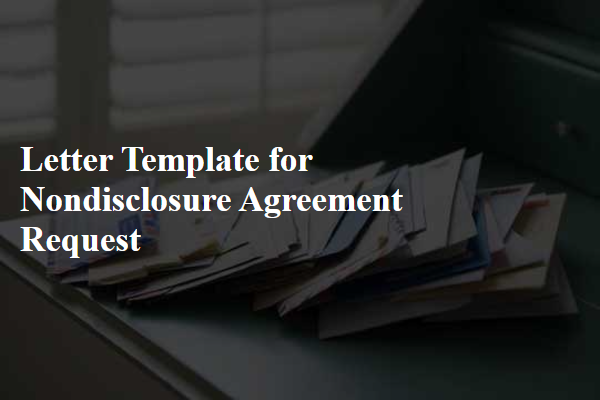Are you considering entering into a partnership but want to protect your valuable information? A nondisclosure agreement (NDA) is a crucial step in safeguarding your proprietary insights and trade secrets. Crafting an effective NDA request letter can set the tone for a trustful relationship while ensuring that all parties are aligned on confidentiality expectations. Dive in to discover key elements and helpful tips for writing your own NDA letter!

Parties Involved
A nondisclosure agreement (NDA) serves as a vital legal document aimed at safeguarding sensitive information shared between involved entities. The parties involved in an NDA typically include Disclosing Party (entity sharing confidential information) and Receiving Party (entity receiving confidential information). For example, a technology startup and a potential investor might engage in an NDA to protect proprietary software details. Adequate identification of entities (full legal names, addresses) is crucial as it clearly outlines responsibilities and obligations to ensure protection of trade secrets, business strategies, and other sensitive data. An NDA becomes enforceable upon both parties' signatures, establishing a binding commitment to confidentiality.
Confidential Information Definition
A nondisclosure agreement (NDA) outlines the terms of confidentiality between parties regarding sensitive information. Key elements of the confidential information definition include proprietary data, trade secrets, business strategies, and technical specifications. Confidential information encompasses any non-public, proprietary knowledge shared during discussions, negotiations, or transactions. Entities involved in the NDA, such as companies or individuals, must ensure clarity on what constitutes confidential information, specifying categories and examples to avoid ambiguity. Ensuring a comprehensive definition prevents unauthorized disclosure, safeguarding intellectual property and maintaining competitive advantage in the market. Proper enforcement of these terms is critical in industries like technology, pharmaceuticals, and finance, where sensitive information is common.
Obligations of Receiving Party
A nondisclosure agreement (NDA) outlines the obligations of the receiving party tasked with safeguarding sensitive information. The receiving party must ensure confidentiality by restricting the dissemination of proprietary details such as trade secrets, business strategies, and product designs. This obligation typically extends to third parties, emphasizing that only authorized personnel may access the information. The receiving party must also utilize the information solely for purposes outlined in the agreement, preventing any unauthorized commercial exploitation. Additionally, the receiving party is usually required to implement reasonable security measures, such as encryption or secure storage, to protect the disclosed information from unauthorized access. Violations of these obligations can lead to legal repercussions, including monetary damages and injunctions.
Term and Termination
Nondisclosure agreements (NDAs) are crucial in protecting confidential information during business transactions. Specific terms outline the duration of confidentiality obligations, typically ranging from one to five years, depending on the nature of the information involved and the industry standards. The termination clause specifies conditions under which either party may terminate the agreement, often including factors such as breach of terms or mutual consent. Additionally, some agreements stipulate a permanent obligation to maintain confidentiality for sensitive information, such as trade secrets, even after termination occurs, ensuring long-term protection against unauthorized disclosures. These clauses must be carefully drafted to ensure enforceability in jurisdictions relevant to the agreements.
Legal Jurisdiction
A nondisclosure agreement (NDA) is essential when confidential information is shared between parties, protecting sensitive data from unauthorized disclosure. Legal jurisdiction, the authority under which legal guidelines apply, determines the venue for disputes arising from the NDA. Common jurisdictions include state laws in California, New York, and Texas, which may establish distinct terms for confidentiality enforcement and penalties for breach of contract. The specific language in the NDA should clearly outline not only the obligations of parties regarding confidentiality but also the applicable legal frameworks and any governing law that pertains to the agreement, ensuring that parties understand their rights and responsibilities in preserving the confidentiality of proprietary information.













Comments